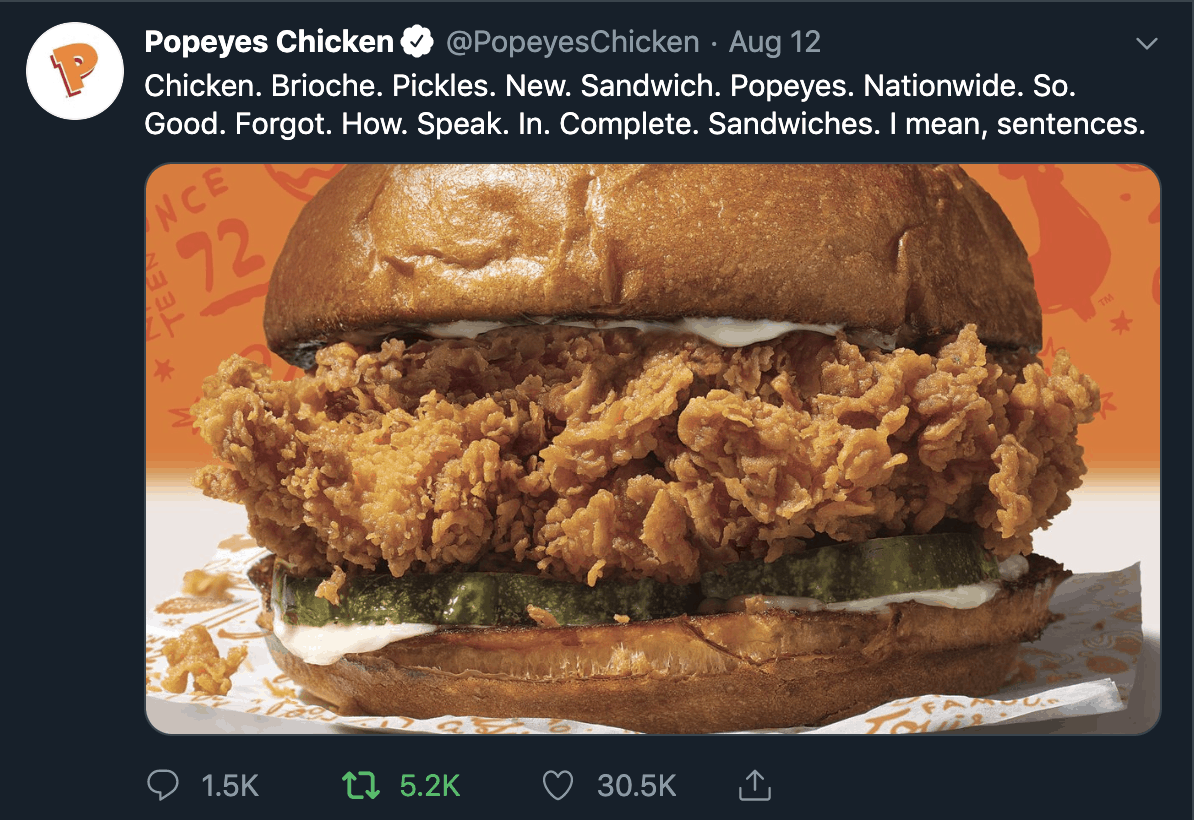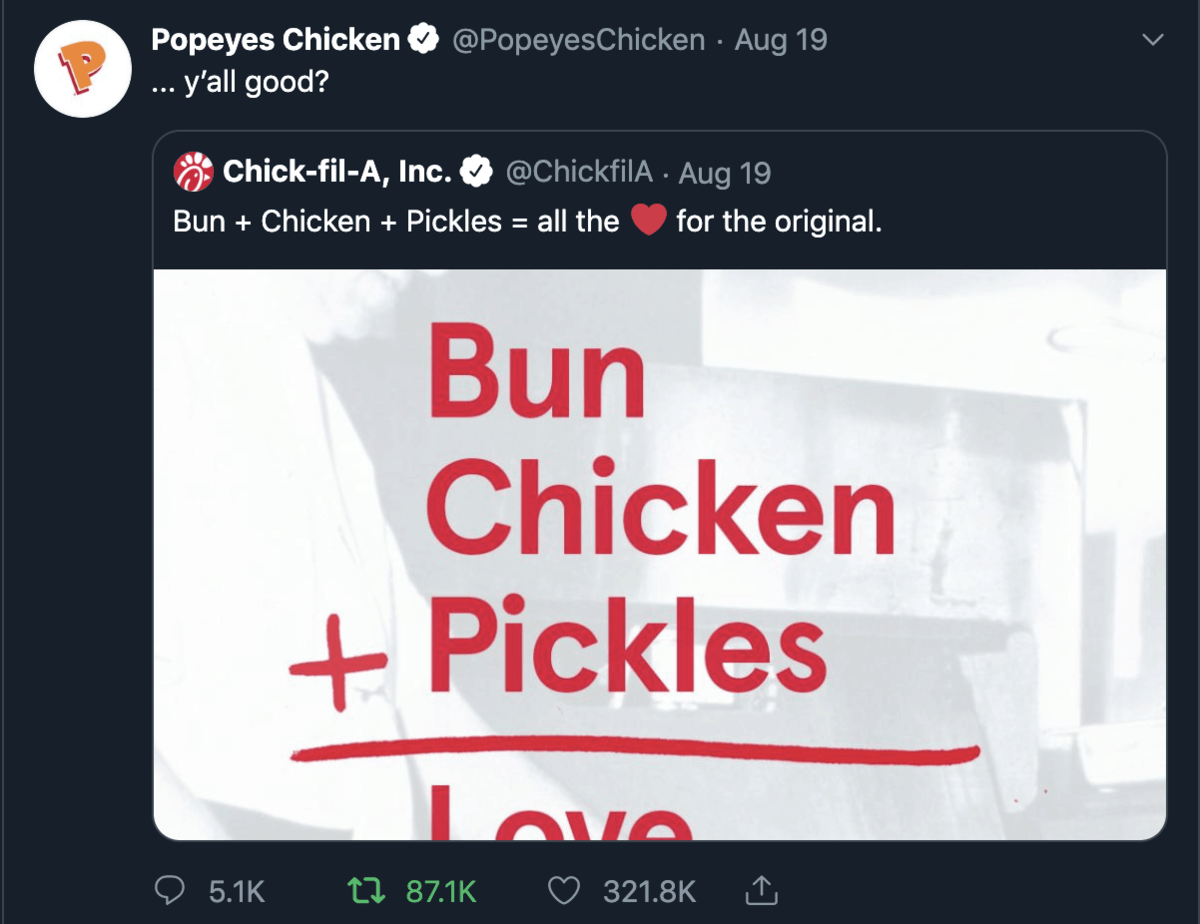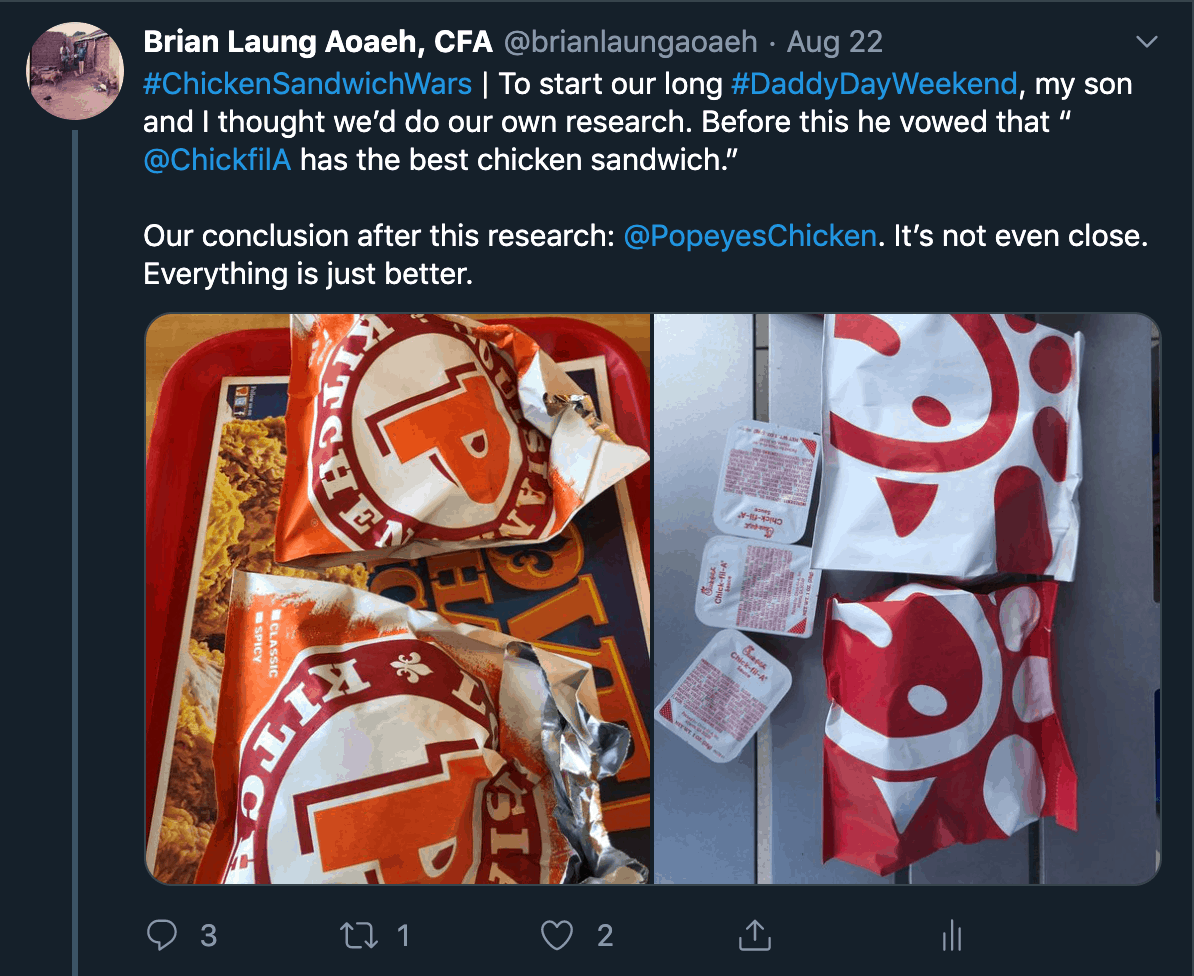FreightWaves features Market Voices – a forum for voices with unique knowledge of numerous transportation/logistics/supply chain sectors, as well as other critical expertise.
If you have been paying attention to the news or social media over the past week or so, there’s little doubt that you have encountered “The Chicken Sandwich Wars of 2019” between Chick-Fil-A and Popeyes Louisiana Kitchen.
In this article, we will briefly discuss the events that have transpired since August 12 in #ChickenSandwichWars.
I will relate this seeming media-centric event to a well-studied but behind-the-scenes problem, known as the bullwhip effect, that plagues manufacturing supply chains everywhere.
I will explain some infrequently discussed issues related to the bullwhip effect.
This article is augmented with observations I made between Thursday, August 22 and Saturday, August 24 when my family succumbed to the frenzy and joined the mania surrounding the #ChickenSandwichWars.[i]

Small, unexpected ripples in the supply chain
According to Reuters, “Popeyes launched its fried chicken sandwich on a buttered brioche bun with pickles on August 12. The launch went mostly unnoticed until its rival Chick-fil-A tweeted a subtle jab referencing Chick-Fil-A’s fried chicken sandwich recipe as “the original.””[i]
As you can see from the image below, Popeyes’ response has garnered 87,000+ Retweets and 321,000+ Likes on Twitter. By comparison, Chick-Fil-A’s tweet garnered less than 3,000 Retweets and 22,000+ Likes.[ii] Popeyes August 12 post of a picture of its chicken sandwich on Instagram has garnered 42,700+ Likes and 4,800+ comments. Chick-Fil-A’s response garnered 24,200+ Likes and 900+ comments. In addition, media reports describe analysis by Apex Marketing Group that estimates that the response earned more than $23 million of ad exposure for Popeyes.

The frenzy was initially driven by discussions on #BlackTwitter – a virtual discussion forum of issues of interest to Black people around the world, that takes place on Twitter, driven mainly by Black people in the United States.[i] As a result, Popeyes locations in Queens have been sold out of the chicken sandwich since Thursday, August 22. When I have called around to ask, employees have not been able to say when they will have more in stock. Those that have not sold out have had lines around the block and hours-long wait times just to get a sandwich. A friend of mine in Charleston, South Carolina tried to get a Popeye’s sandwich after reading my tweet about it and reported a wait time of at least two hours at the location from which he tried to buy one on August 22. My family succeeded in getting the sandwiches because we were traveling between Connecticut and New York and stopped at two locations in Connecticut to buy them. There were no lines on Thursday, August 22 but that had changed by Saturday, August 24 when there were lines inside each location we visited, as well as outside, in the drive-thru lanes at the two locations we visited on Saturday.
While the chicken sandwich eating-public is keeping its jowls busy with the tasty goodness of chicken sandwiches, the bullwhip effect is playing out across Popeyes supply chain in ways the company could not have predicted beforehand.
When unexpected perturbations create problems of increasing severity throughout the supply chain
Business Insider reports that Popeyes spent a year developing the chicken sandwich, creating a marketing campaign, and getting new equipment to its stores. The same Business Insider article reports that Popeyes has seen climbing sales in boneless chicken, and also that its sister-brand, Burger King, has seen increasing sales of its chicken sandwich.[ii] Nonetheless, those that manage supply chains at Popeyes were unlikely prepared for the response that started on August 19.
A supply chain is a network of organizations that collaborate with one another to facilitate the creation and movement of products from producers to consumers. This process involves sharing information about conditions along the supply chain. Sometimes, due to inaccurate information, or information that has been incorrectly forecast, a situation develops in which there are increasingly wild distortions along the supply chain related to the material inputs necessary to meet demand. This is the phenomenon known as the bullwhip effect; The name is meant to evoke the way the amplitude of a bullwhip rises and falls between increasing extremes due to a relatively small effect where the distortion begins.
In this case, one tweet led to a cascading effect on social media, that then led to a run on Popeyes stores all over the United States.
According to Popeyes’ tweet on August 12, the sandwich is manufactured from the following ingredients:
- Chicken – they do not state this specifically, but I assume it’s made with breast meat.
- Brioche buns – requiring all-purpose flour, salt, sugar, yeast, eggs, butter and water.
- Pickles.
- Mayonnaise – regular or spicy, made with eggs, lemon juice, vinegar, salt and oil.
The suppliers responsible for providing Popeyes with these ingredients make their plans based on historical trends and patterns. We can assume they would each allow for a small variance or error term in such forecasts. Since Popeyes has spent more than 12 months preparing for the launch, I assume the company ran small trials in a handful of markets to determine what assumptions they’d need to make about potential demand for the sandwich.
I do not know what factor social media played in the research and development leading up to August 12. I am confident Popeyes’ market researchers did not predict that Chick-Fil-A would subtweet their announcement, nor would they have predicted the response on Twitter, and the enthusiasm that swelled from the dialogue on social media following that tweet.
Imagine the chaos that ensues when, starting on August 19, demand for the chicken sandwich shot through the roof. The reader with no understanding of supply chain would be forgiven for thinking, “Okay, just order more stuff to make more sandwiches! What’s the problem?” Well, it’s not that straightforward – it takes time to process the wheat that is used to make flour, and then to get that flour to the bakery that makes the buns. It takes time to increase the production of eggs. It takes time to raise additional chickens to meet the increased demand for breast meat that arises from the surge in demand for sandwiches. It takes time to produce more milk from which to churn butter. It takes time to grow the cucumbers or zucchini that are used in making pickles. It takes time to produce the ingredients that go into producing the mayonnaise.
Moreover, the same suppliers that serve Popeyes probably serve its competitors too, and so it is unclear that there is enough extra stock available to account for this unexpected surge in demand for Popeyes chicken sandwiches. In fact, given the numerous instances of Popeyes locations being sold out of the sandwich, it is probably more accurate to say that there’s most definitely insufficient safety stock of at least some of the ingredients for the chicken sandwich.
The discrepancy between the instantaneous nature of demand for, and consumption of, the sandwich and the amount of time that it takes upstream suppliers to produce the chicken, eggs, flour, pickles, mayo and oil required to make the sandwich is what leads to the bullwhip effect.
Essentially, in order to avoid running out of the sandwich, Popeyes needs to place larger orders for product from each of its upstream suppliers. This leads Popeyes suppliers to place even larger orders from their own suppliers, and so on, through the supply chain because, for example, the flour mill must account for the even longer time it takes to source and procure extra wheat that meets Popeye’s requirements. A related issue is that it also takes time to arrange for additional supply chain logistics capacity to meet the surge in demand by transporting supplies to each of Popeyes stores in the United States, especially since this would require specialized trucking services.
Some downstream effects that arise due to the bullwhip effect
Downstream consequences and effects of the bullwhip effect were on display in each of the locations that I observed. Here are a few issues that I noticed:
- First, while I was in line, I noticed that other menu items were being ignored. The vast majority of people in line wanted the chicken sandwich. As a result, for example, the fried chicken that Popeyes is known for sat unpurchased behind the counter. Repeat this across Popeyes’ entire network and it’s easy to see how suddenly there’s an increase in chicken inventory that the company has not anticipated. Given that these menu items are perishable, this could quickly become another problem for the supply chain operations team at Popeyes.
- Second, assume that a Popeye’s location is accustomed to serving between 100 and 200 guests each day. Suddenly, say they had 500 to 600 people coming in to order the chicken sandwich on Friday, August 23. Even if they have enough of the ingredients to meet demand that day, their ability to assemble the sandwiches quickly enough to serve all these guests at their customary rate will be constrained by the equipment available at the location. This leads to delays, long lines and so on.
- Finally, given that employees were not trained to deal with such an influx of guests within such a short period of time, service deteriorates because employees become stressed and start to make mistakes they wouldn’t normally make. This may call for some employees to work overtime, leading to fatigue. (Author’s comment: Based on my experience, I hope Popeyes executives give every front-line employee a small bonus as an expression of gratitude. The employees at the locations I visited looked very stressed.)
The promise and limitations of technology – cognitive supply chains
In Logistics network optimization – why this time is different, I wrote about how new technology is driving changes taking place in the way supply chain logistics networks are optimized. In theory cognitive supply chain management software should be able to ameliorate the sorts of problems described above. However, as I have already suggested, I am not entirely convinced that new technology would have been able to anticipate, predict and then suggest an optimal tactical plan to enable Popeyes to maximize the potential benefits of the #ChickenSandwichWars. A system to accomplish that would require data that is unlikely to have been available to Popeyes before August 19. So now the question is this – what systems does Popeyes have in place to convert this surge in enthusiasm into a sustained increase in demand for its chicken sandwiches?
Accidentally or not, Popeyes is now in direct competition with Chick-Fil-A and all the other quick service restaurants that served fried chicken sandwiches before Popeyes joined the fray on August 12.[i] The social media frenzy has brought many new customers through its doors, and created brand awareness where there was previously none. Is Popeyes ready to meet that demand? Only time will tell.
In case you are wondering, in my opinion the
Popeyes fried chicken sandwich is truly amazing. I think it’s much better than
the Chick-Fil-A sandwich. I tried both.

[i] See: @brianlaungaoaeh #ChickenSandwichWars for details. Additional media: The New Yorker – The Popeyes Chicken Sandwich Is Here To Save America, and The Washington Post – Yes, the Popeyes chicken sandwich is great. Here’s how it stacks up against the competition.
[ii] This is not something Popeye’s could have predicted beforehand, planned for, or included in supply chain modelling software; How would one know that Chick-Fil-A will subtweet Popeyes, and that the Popeyes social media manager would respond in a way that captured the imagination of people on social media?
[iii] Data is as of the writing of this article, on Sunday, August 25, 2019: On Twitter, Popeyes has 158,000+ followers, while Chick-Fil-A has 1,100,000+. On instagram, Popeyes has 268,000 followers while Chick-Fil-A has 1,500,000.
[iv] See: https://en.wikipedia.org/wiki/Black_Twitter
[v] Burger King and Popeyes are owned by Restaurant Brand’s International.
[vi] Wendy’s, Shake Shack, Bojangles, and a few other chains, each tried to muscle in on the action. They failed.








Josh Futterman
Great analysis. Definitely left me wondering whether it is possible to create cognitive AI software that can accurately assess the impact of product intro marketing campaigns and apply them to forecast supply chain and service requirements. Could using existing data from prior campaigns enable reasonably accurate forecasts?
Denise
In addition to all that frenzy a local restaurant here in Philadelphia, Country Cooking locates at 22nd & Lehigh Ave. had their own chicken sandwich and laid out the Chik Fila and Popeyes and their version on their Instagram page countrycooking1.